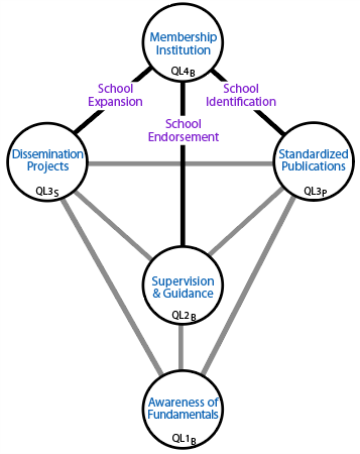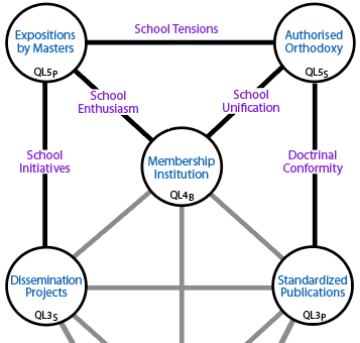Determining the Orthodoxy: L4 & L5
L4: Formalized Membership
The formalized membership body is the official home of the doctrine. It is set up partly to serve the identity and interests of adherents within society. However, above all, it exists to provide a focus for organised dedication to the perpetuation and use of the orthodox doctrine. Non-member adherents may, and often do, develop the doctrine independently but the likelihood of abandoning the strict orthodoxy then increases greatly.
Centre
Dynamic Duality: The created institute is a social embodiment of the school's orthodoxy, and this is a group matter. At the same time, maintenance of the institution is the task of each individual member who cares about the doctrine and its orthodox perpetuation.
So, in the Tree, this level becomes a single balanced Centre:
is labeled .
Psychosocial Pressure ![]() :
:
Channels
L4 ↔ L3

The institute is maintained by its members' continuous focus on the doctrine and its proper formulation and application. So repetitive re-statements of the doctrine, examples of the value of the doctrine and especially creation of are basic ways to identify with the School and for the School to know itself. Members typically find this work gratifying and their acceptance and appreciation by the School keeps them involved and supportive.
Channel is labeled: School Identification.
support in order to attract new adherents. Such events allow informal contact between members and interested outsiders and provide an opportunity to explain both the doctrine and role of the in its promotion.
Channel is labeled: School Expansion.
L4 ↔ L2:
The grows through new individuals joining, but requires such applicants to be indoctrinated via . This is to ensure genuine adherence to the orthodoxy, and protect the reputation and future of the school. So this activity is promoted and endorsed. Those engaged in promote their membership and endorse the membership body in regard to its importance for maintaining and spreading the orthodox doctrine.
Channel is labeled: School Endorsement
L4 ↔ L1:
does not directly determine or affect the , and vice versa: mediation via mentoring or active dissemination is required. So there is no direct channel.
L5: Recognized Guardianship
If the doctrine is to outlive its founder and early adherents, a focus on guarding its integrity and ensuring orthodox transmission is necessary. The doctrine can be safely transmitted in practice: first, by accepting statements of the orthodoxy from authorized invididuals without argument or doubt; and second, by appreciating the doctrine through listening and learning from charismatic masters, and spontaneously identifying with them. These approaches naturally impact on Centres in other levels.
Centres
Dynamic Duality: Two types of guardians of the doctrine were identified: socially authorised orthodox leaders and emergent personal masters of the doctrine, and these correspond naturally to the poles of the L5-duality.
So this level in the Tree will generate two polarized but connected Centres:
and .
is labeled
is labeled .
Maintenance of the school as a viable group unified by its doctrine depends on the orthodox leaders. Depending on the unpredictable views of charismatic masters is risky because such individuals may generate doctrinal schisms and ultimately split the membership body. So the social pole is dominant and placed on the right in the Tree.
Psychosocial Pressure ![]() :
:
Channels
L5
The two L5-Centres are linked because get trust and validation from their deep appreciation of orthodox formulations. Because reject rules and slavish adherence to custom, what they say has the potential to sow division or even create a schism. Formal benefit from the vitality and enthusiasm injected by , but are always concerned that divergence does not go too far. The relationship is therefore uneasy.
Channel is labeled School Tensions.
L5 ↔ L4
The requirement for secure transmission puts an onus on the membership body.

What say counts because their formulations are taken as the definitive orthodoxy. Perpetuation of the orthodox doctrine is the primary rationale of the institute, and creates the common bond amongst members. So official orthodoxy provides the substance of its mission to perpetuate the doctrine.
Channel is labeled School Unification.
The opportunity to learn from charismatic masters is typically highly valued and sought after by members. The membership body looks for ways to take advantage of this by facilitating interactive events. Expositions by masters generate excitement and may attract large crowds.
Channel is labeled School Enthusiasm.
L5 ↔ L3
There is a natural link between of the doctrine and its . In this case, there are 4 possible channels.
directly impact on the creation of . Those writings are expected to adhere to orthodox formulations. They may need to be checked for anything too idiosyncratic and approved as orthodox
Channel is labeled Doctrinal Conformity
However, have a political dimension and can only be indirectly impacted by . Projects seek to expand and support theand this is what determines social dissemination.
So there is no direct Channel.
() directly activate and facilitate . The projects often engage the masters who commonly desire to participate.
Channel is labeled School Initiatives
However are too idiosyncratic and potentially socially risky for an ordinary member to use them as the basis for their unless and until aspects of those teachings have been vetted either by the or by the .
So there is no direct Channel.
L5 ↔ L2 & L1
L5 ↔ L2: do not directly influence which must focus on the immediate need to provide a basic doctrinal understanding to meet the needs of a particular person and issue. Any influences would be mediated by the or . Nor does directly influence and vice versa. So there is no direct channel.
L5 ↔ L1: As at , affirming does not directly influence and vice versa. So there can be no direct channel.
-
Continue to Levels 6 and 7 which enable modification of the orthodoxy.
Originally posted: 4-Dec-2022. Last updated: 25-Aug-2025.